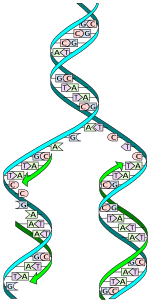DNA replication
DNA replication is the process of copying a double-stranded DNA molecule. Both strands serve as templates for the reproduction of the opposite strand. The process is sometimes called "semi-conservative replication" because the new DNA from the original strand contains half of the original and half of the newly synthesized DNA.

This process occurs in all life forms with DNA.[1] There are some differences in the control of DNA replication in prokaryotic and eukaryotic organisms.
In a cell, DNA replication begins at specific places in the genome, called origins.[2] As the DNA unwinds and as DNA helicase rips apart the double helix structure of DNA,[3] the synthesis of new strands forms at a replication fork.[4] In addition to DNA polymerase,[5] other enzymes at the fork help to start and continue the DNA synthesis.
DNA polymerase
changeDNA polymerases are a family of enzymes that carry out all forms of DNA replication.[6] However, a DNA polymerase can only extend an existing DNA strand paired with a template strand; it cannot begin the synthesis of a new strand. To begin synthesis, a short fragment of DNA or RNA, called a 'primer', is created and paired with the template DNA strand.
In general, DNA polymerases are extremely accurate, making less than one mistake for every 107 (10 million) nucleotides added.[7] Even so, some DNA polymerases also have 'proofreading' ability: they can remove nucleotides from the end of a strand in order to correct mismatched bases.
DNA repair
changeDNA in cells is constantly being damaged.[8] The nucleus of cells contains a number of repair mechanisms which fix almost all of this damage. "A large set of DNA repair enzymes continuously scan the DNA and repair any damaged nucleotides".[9]
References
change- ↑ Most viruses use RNA instead.
- ↑ Berg J.M.; et al. (2002). Biochemistry. W.H. Freeman. ISBN 0-7167-3051-0.Chapter 27, Section 4: DNA Replication of both strands proceeds rapidly from specific start sites
- ↑ Encyclopaedia Britannica (2023-03-20). "DNA replication". britannica.com. Retrieved 20 March 2023.
- ↑ Mazouzi, Abdelghani; Velimezi, Georgia; Loizou, Joanna I. (2014-11-15). "DNA replication stress: Causes, resolution and disease". Experimental Cell Research. DNA DAMAGE AND REPAIR. 329 (1): 85–93. doi:10.1016/j.yexcr.2014.09.030. ISSN 0014-4827. PMID 25281304.
- ↑ The enzyme which synthesizes new DNA by adding nucleotides matched to the template strand.
- ↑ Berg J.M.; et al. (2002). Biochemistry. W.H. Freeman. ISBN 0-7167-3051-0. Chapter 27, Section 2: DNA Polymerases require a template and a primer
- ↑ McCulloch S.D. & Kunkel T.A (2008). "The fidelity of DNA synthesis by eukaryotic replicative and translesion synthesis polymerases". Cell Research. 18 (1): 148–61. doi:10.1038/cr.2008.4. PMC 3639319. PMID 18166979.
- ↑ Causes include reactive molecules, chemicals and radiation from the environment, and damage caused by heat.
- ↑ Alberts B et al 2002. Molecular biology of the cell. 4th ed, Garland. p275. ISBN 0-8153-3218-1
Other websites
change- DNA Workshop
- WEHI-TV - DNA Replication video Archived 2007-10-12 at the Wayback Machine- Detailed DNA replication animation from different angles with description below.
- Basic Polymerase Chain Reaction Protocol Archived 2007-10-13 at the Wayback Machine
- Animated Biology Archived 2007-10-27 at the Wayback Machine
- DNA makes DNA Archived 2004-09-15 at the Wayback Machine (Flash Animation)
- DNA replication info page by George Kakaris MSc.
- Reference website on eukaryotic DNA replication
- [“DNA Replication.” Genome.gov, https://www.genome.gov/genetics-glossary/DNA-Replication.]
- [“Structure and Composition of DNA.” Encyclopædia Britannica, Encyclopædia Britannica, Inc., https://www.britannica.com/science/heredity-genetics/Structure-and-composition-of-DNA#ref944097.]